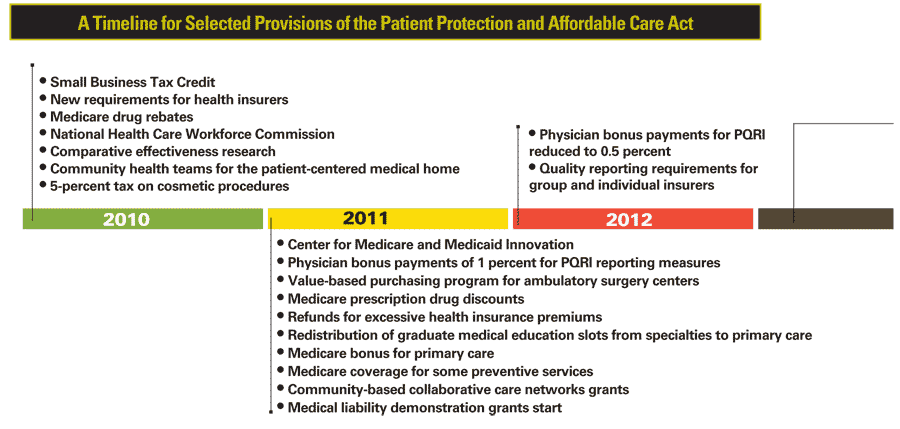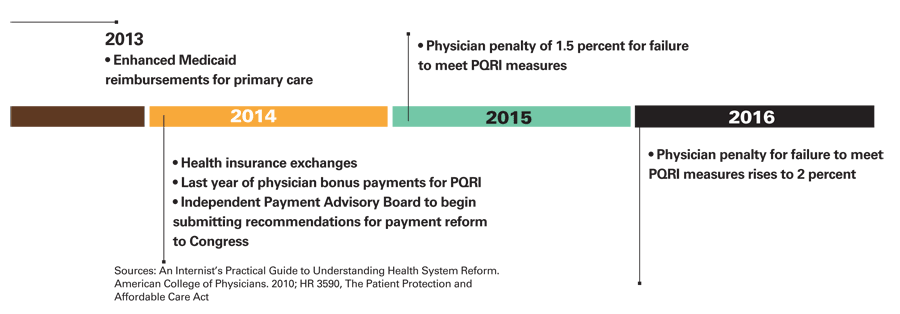Although President Obama signed the Patient Protection and Affordable Care Act six months ago, regulators, bureaucrats and advisory panels are now sharpening their pencils to write the regulations that will actually put its provisions into practice, namely your practice, over the next few years.
For ophthalmology, the Affordable Care Act, or PPACA, represents a mixed bag. The unabashed goal of the legislation is to extend health insurance to all via an emphasis on primary care. That, of course, means less emphasis on specialists.
Besides extending health insurance coverage to 95 percent of all legal
PPACA is replete with provisions that will get rolled out in phases over the next few years. The easy stuff—the small business tax credits, some new requirements for health insurers, Medicare drug rebates and comparative effectiveness research (OK, maybe not that easy)—is rolling out this year. Next year will see Medicare prescription drug discounts, bonuses for primary care and Medicare coverage for some preventive services. Out years will impose quality reporting measures on insurers, enhanced payments for primary care and health insurance exchanges. The law also would impose bonuses and penalties on Medicare payments to physicians, and tighten reporting requirements for ambulatory surgical centers and physician investments. Here's a glimpse of how provisions in the Affordable Care Act could impact your practice.
 SGRs
SGRs
First, a few words on what the Affordable Care Act does not do: fix Medicare's Sustainable Growth Rate. In fact, the words "sustainable growth rate" are nowhere to be found in the 906-page House bill. Thought leaders agree that cleaning up this business later this year is critical for medicine.
Earlier this year, physicians were looking at a 21-percent cut in the Medicare fee schedule as an adjustment to the SGR, but Congress took stopgap action in June to forestall the cut and raise the schedule another 2.2 percent through November. "Right now of course, Congress has to come back after election in a lame duck session and solve the SGR problem or we'll have the 23-percent decrease for December 1 and another 6 percent on January 1," says Michael X. Repka, MD, medical director of government affairs for the
The inertia surrounding SGRs, along with the end of the Medicare Advantage program (which guarantees a profit to HMOs who write Medicare policies), will continue to build pressure on physician reimbursements, says Robert M. Berenson, MD, a fellow at the Urban Institute in Washington, D.C., and a member of Obama's transition team. "We will never see an SGR cut of 22 percent, but there will be continuing pressure on physician payments and hospital payments in the traditional Medicare program, and I assume it will build up somewhat from private payers as well," he says. That may drive some providers to form alliances and their own accountable care organizations, or ACOs, he says.
Dr. Repka explains why the act excluded SGRs. "Congress did not put SGRs in health-care reform because it would've made health-care reform cost an extra $300 billion and that would've made it look even more expensive," he said.
SGR of the Future?
The Affordable Care Act does create an Independent Payment Advisory Board, or IPAB. IPAB can submit recommendations to Congress beginning in 2014 to reduce the growth in Medicare expenditures. Dr. Repka calls this the biggest worry for ophthalmology.
"Their goal will be to cut spending—presumably it's going to become the SGR of its era," he says. "They have cost targets to meet. If the projected costs for a year are going to be a certain amount, then that's going to trigger a reduction in outpatient payment rates." Initially IPAB will only regulate physician payment, but ultimately it will extend to hospitals. "I don't know that IPAB will look quite like it does right now nine years from now," he says.
More Eye Exams or Screenings?
Buried within the provisions for near universal coverage are clauses to extend vision benefits to more people. One provision defines the "essential health benefits package" to include "pediatric services, including oral and vision care." Richard Sanchez, president of the National Association of Vision Care Plans, says plans are bracing for more members. Trends bode well for vision coverage. Membership in vision plans actually increased 1.2 percent and eye examinations increased 5.6 percent over 2008, according to NAVCP data. "That was a bit of a surprise with the economy," Mr. Sanchez says.
 However, the act would ban stand-alone vision plans from participating in health insurance exchanges; vision plans would have to contract with medical plans. Mr. Sanchez says his organization is lobbying Congress to get that ban lifted, and Sen. Debbie Stabenow has drafted an amendment to that effect. However, the AAO and the American Optometric Association have sent a joint letter to Sen. Stabenow voicing objections to the amendment. The letter criticizes stand-alone plans for isolating vision care from health care. "Such plans are routinely mislabeled as complete or comprehensive when in fact they are not," the letter states. NAVCP countered with a press release that stated individuals in stand-alone vision plans are twice as likely to get annual eye examinations as those who have vision coverage through a medical plan.
However, the act would ban stand-alone vision plans from participating in health insurance exchanges; vision plans would have to contract with medical plans. Mr. Sanchez says his organization is lobbying Congress to get that ban lifted, and Sen. Debbie Stabenow has drafted an amendment to that effect. However, the AAO and the American Optometric Association have sent a joint letter to Sen. Stabenow voicing objections to the amendment. The letter criticizes stand-alone plans for isolating vision care from health care. "Such plans are routinely mislabeled as complete or comprehensive when in fact they are not," the letter states. NAVCP countered with a press release that stated individuals in stand-alone vision plans are twice as likely to get annual eye examinations as those who have vision coverage through a medical plan.
So no one is quite sure what the words "vision care" in the Affordable Care Act mean. "There will be some new business in terms that health exchanges have to provide medical-surgical care and they also have to provide some level of dental and some level of vision," Dr. Repka says. "The level of vision is yet to be defined, but the law says it has to be about what's already offered in the private sector at this time. The expectation is there's going to be some refraction coverage and probably some device coverage."
Mr. Sanchez concurs: "Especially for children, that vision benefit still needs to be defined, whether it's going to involve a screening or a benefit with materials."
Beyond vision coverage, near universal medical coverage should mean more patients, but Dr. Repka sees the resulting increase as moderate in the typical ophthalmology practice. "The more advanced care in ophthalmology isn't going to be impacted greatly in volume," he says. "There will be some, but it's generally going to be from younger patients who don't have eye disease. There may be some more diabetics who will have coverage and will come in for care—I hope."
Traci Fritz, a manager at two small ophthalmology practices in


Workforce Issues
Of course, even a slight uptick in patients could stretch what some consider is an already strained workforce in ophthalmology, especially with the shift away from specialties.
Beginning next year, the act would redistribute unused residency slots to hospitals that would use them for primary care and set a target that 65 percent of all residency slots are designated for primary care and general surgery.
The Affordable Care Act also calls for creating Primary Care Extension Programs under the Agency for Health Research and Quality (AHRQ) based on the model of the Agricultural Extension Service along with Medicare bonus payments for primary-care services, according to the
Gail Wilensky, PhD, who was administrator of CMS' predecessor agency, the Health Care Financing Administration under President George H.W. Bush, summarized the thinking behind the push toward primary care at an
The AAO last year joined with 20 other surgical organizations in sending a letter to senators that decried the Medicare changes as "exacerbating workforce shortages," according to a joint statement. The Affordable Care Act establishes a national health-care workforce commission to address workforce shortages, particularly in low-income, underserved, uninsured, minority, health disparity, and rural populations—but it doesn't specify specialties.

Most Money Goes Elsewhere
The Affordable Care Act extends bonus payments for all providers who meet reporting measures under PQRI, the Physicians Quality Reporting Initiative. The bonus will be 1 percent of total Medicare receipts in 2011 and 0.5 percent in 2012 to 2014, according to the ACP.1 That's the carrot. The stick comes in 2015, when physicians who do not participate in the PQRI program will see payment reductions of 1.5 percent, rising to 2 percent in 2016 and all following years.
But most of the incentives go to primary care. Next year, for example, Medicare will pay a 10-percent bonus on top of the fee schedule for office, nursing home and custodial care visions, according to the ACP.1 To qualify, 60 percent of the physician's Medicare billings must be in primary care.
"There is a lot of pressure on money going to primary care," Dr. Repka says. "One thing health-care reform did is to move some money to primary care in the form of bonuses, but at least they were not budget neutral, so specialists shouldn't take a hit to fund them."
ASCs and Physician Investment
Subtitle C of the Affordable Care Act authorizes CMS to implement a value-based purchasing program for Medicare payments for ambulatory surgery centers. That would include public disclosure of ASC performance measures.
Eric Zimmerman, a Washington, D.C., lawyer, reported that this means instead of CMS adjusting ASC facility fee payments annually for inflation, CMS would instead use a "productivity adjustment," a 10-year rolling average of productivity gains in the general economy.2 This could result in a negative update, his report said. The law could also extend Medicare's acquired conditions policy, which now applies only to hospitals, to ASCs in the future, he stated.
Meanwhile, any device manufacturer that provides payments to physicians will have to begin reporting that to Health and Human Services beginning in March 2013 and then annually afterward. HHS would then supply states with reports of those physicians beginning in September that year. This would extend to clinical investigations, according to Section 6002 of the act. Disclosure provisions would also require drug makers to submit annual reports to HHS of recipients of all samples and the quantity.
Liability Reform (Lite)
The Affordable Care Act did nothing to reform medical liability, but it does empower Congress to establish state demonstrations to evaluate alternatives to the existing court-based approach. The $50 million authorized for state grants—$10 million a year over five years beginning in 2011—may seem paltry compared with the $10 billion to $60 billion varied sources have estimated as the direct cost of medical litigation. The Agency for Healthcare Research and Quality is soliciting applications for the demonstrations.
Such is the state of the Affordable Care Act today, but that could change. While attorneys general in 20 states have joined a federal court challenge to the law and
Short of repeal, tweaking of the law is an option. "We have a number of elections and a number of possible bills that could modify this plan as we go year to year, depending upon the outcome of each election and the will of the Congress at the time," Dr. Repka says. "It's a dynamic process, but personally I see no chance of elimination of the whole thing, going back to status quo because that doesn't solve the issues that led to this in the first place, which were rising cost and access."
1. An Internist's Practical Guide to Understanding Health System Reform.
2. Zimmerman E. Health care reform: Legislation affects ambulatory surgery centers. April 1, 2010.



